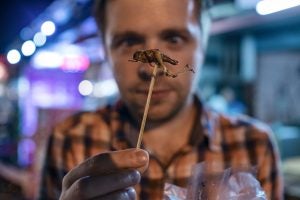Is there a soldier fly in your future? An article in the the March/April 2023 issue of Discover magazine touts it the “potential planet savior.” According to John Riha, the author of A Taste for Waste, the ¾-inch long fly will eat almost any organic waste.
With only a week lifespan, the adult female spends most of its time laying eggs on organic waste of all kinds — from discarded food to manure. The larva are voracious and consume their weight twice every day for two-three weeks before pupating and completing the bug’s 30 to 40 day lifespan.
Further in its favor, Hermetia illucens it is not a pest of living plants and doesn’t bite or vector diseases. It is not a good flyer, so it’s not likely to be a pest around your barbecue unless your compost pile is near.
The mature grubs are full of proteins and fats. Their excrement, called frass, resembles coffee grounds, and is rich in plant nutrients. So there you have it: an organism that converts waste to easy-to-use fertilizer while contributing its grub and adult forms to food for livestock and … humans.
Don’t throw up. They’re not likely to be a human food in the U.S. anytime soon.
But around the world, some 2 million people include insects in their diet — intentionally. According to Chapter 11 of the book, The Economics of Sustainable Food, edited by Nicoletta Batini, in Cape Town you can find a dairy substitute called EntoMilk made from soldier fly larvae, ice cream made from EntoMilk and honey, dumplings with EntoMilk filling, and a canape filled with EntoMilk cheese and mushrooms, topped with toasted soldier fly larva and microgreens.
Are you hungry yet?
The soldier fly is just one bug among many eaten around the world, according to Batini. Thirteen percent of insect species eaten are beetles, 18 percent moth larva, 14 percent bees, wasps and ants, 3 percent termites, 3 percent dragonflies, and 7 percent flies and other insects.
Insects are seldom considered food in advanced societies because if the ick factor. But that is beginning to change. In central Europe, the cockchafer beetle is often a component of soup.

And guess what. The food processing giant Archer-Daniels-Midland is building a huge soldier fly farming facility in Decatur, Illinois. The 750,000-square-foot facility will grow billions of H. illucens in stacked bins, providing 8.6 million square feet of breeding surface. They plan to produce 60,000 tons of protein product yearly, as well as 20,000 tons of oil and 400,000 tons of frass, the latter to be used as organic fertilizer.
Consider this: A one-acre (43,560 square feet) facility such as ADM’s “can produce the same amount of protein and fats as a 2,500 acre cattle farm or 100 acres of soybeans,” according to that Discover magazine article. Cattle feed will be the main outlet for the protein and fats. ADM plans to feed the grubs corn fodder.
ADM is partnering with InnovaFeed, a Paris-based biotech company specializing in soldier fly growing and processing. InnovaFeed has two ADM-type facilities in France and plans to build 10 more around the world by 2030.
Animal protein is in short supply or too expensive in many undeveloped countries, so insect protein is a viable substitute and has been eaten in some societies for millennia. The technology developed by InnovaFeed could easily be scaled down to serve small communities, even households, in Africa and South Asia.
Discover magazine claims novelty menu items that include insects are also catching on in North America and Europe — barbecue-flavored mealworms, cricket flour, and fruit-flavored suckers that “house whole scorpions.”
So far no soldier fly items, but one blogger describes the larvae taste as “an earthy chocolate-like, malty, fish flavor,” a bit hard for my taste buds to imagine. Hui Long Yu, a student at Xiamen University, has published a paper promoting soldier fly larvae fat as a butter alternative.
ADM may be prescient with their soldier fly project. Traditionally soybeans have been crushed for the meal to feed livestock. The oil has had to search for markets, and of course it is used in hundreds of products from food to ink to plastics. Increasingly it is used for biodiesel, so much so that a dozen or more Midwest crushing plants are expanding their capacity, and new plants are on the drawing board.
One concern is: Can soybean production keep up with future oil demand without destroying Brazil’s forests and savannas? New farmland in the U.S. is limited. Soybean expansion will have to come mostly at the expense of other crops. Projects such as ADM’s can substitute for soybean acres.
I have poked a little fun at eating insects, as I think most people in my generation (Depression babies) and Baby Boomers cringe at the thought. However, a survey reported in the “ConvenienceStore” website says 50 percent of all consumers say they have switched brands due to ESG (environmental, social or governance) considerations. By the time you survey millennials (born 1980-1994), the switch is 70 percent.
Consumers educated in the age of climate and social awareness are changing our world, even when governments can’t. Maybe my great-grandchildren, of which I now have five, will think nothing of a soldier fly main course.
Jack DeWitt is a farmer-agronomist with farming experience that spans the decades since the end of horse farming to the age of GPS and precision farming. He recounts all and predicts how we can have a future world with abundant food in his book “World Food Unlimited.” A version of this article was republished from Agri-Times Northwest with permission.



